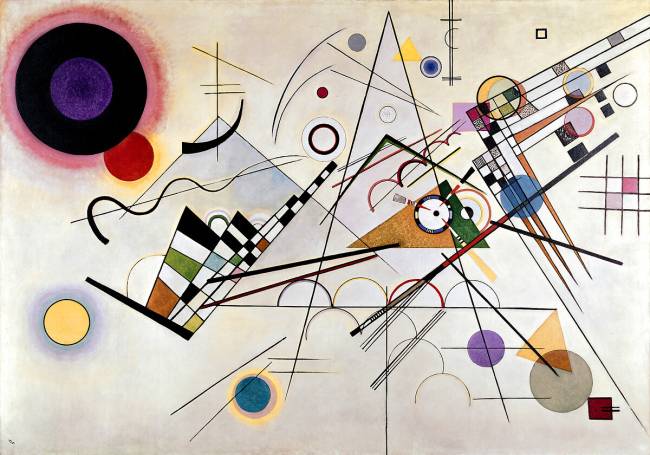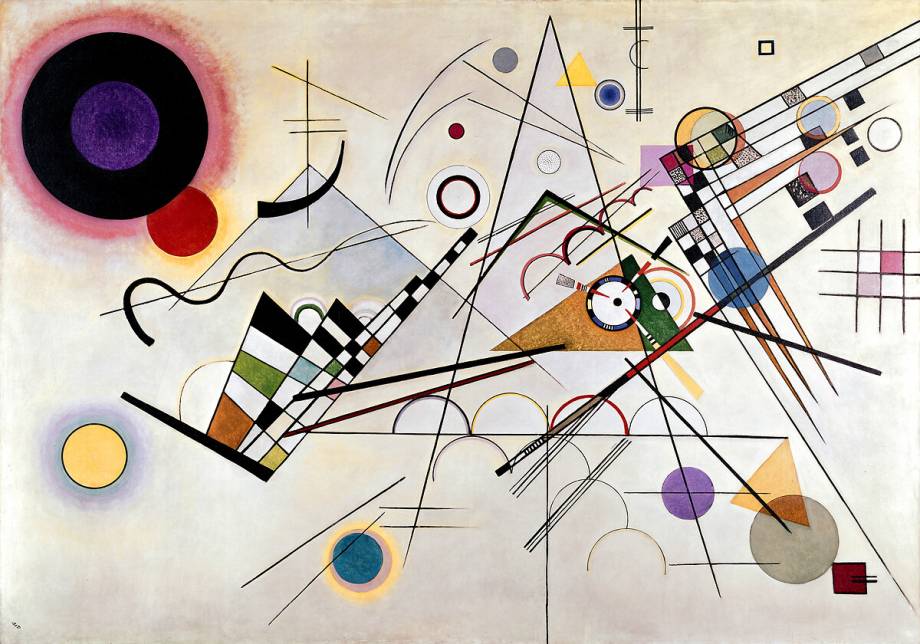Shop art print and framed art Composition VIII by Wassily Kandinsky
Customise
Your art print
Composition VIII OF Wassily Kandinsky
Composition VIII
Wassily Kandinsky's Composition VIII: an emblematic work of abstract art
Wassily Kandinsky is considered one of the pioneers of abstract art. His Composition VIII, created in 1923, is one of his major works. It is exhibited at the Guggenheim Museum in New York, where every year it attracts thousands of visitors from all over the world to admire this masterpiece of abstract art.
The explosion of shapes and colours
This oil painting on canvas measures 140 x 201 centimetres and is characterised by its use of simple geometric shapes and bright colours. At first glance, you can see a myriad of geometric shapes - circles, rectangles, triangles, straight and curved lines - that seem to clash and overlap. The colours used are very varied, ranging from primary colours (red, blue, yellow) to more complex shades (olive green, violet, ochre). In addition, Kandinsky plays with the contrasts between the different colours and textures, creating a dynamic visual effect.
A structured and balanced composition
Despite this apparent profusion of shapes and colours, Composition VIII has a rigorous organisation and a certain harmony. The elements are arranged to create strong axes and an overall balance. Similarly, empty or monochrome spaces alternate with denser, more colourful areas, giving the whole an impression of coherence and unity.
The legacy of the Bauhaus movement
The making of Composition VIII coincides with the time when Wassily Kandinsky was teaching at the famous Bauhaus, a German art and design school founded in 1919 by Walter Gropius. The Bauhaus played a crucial role in the emergence of modernism and abstraction, advocating an avant-garde and experimental approach to architecture, design and the decorative arts.
Influence of theories on form and colour
At this institution, Kandinsky was exposed to theoretical reflections on form and colour, which fed into his own artistic approach. In particular, he drew on the work of Paul Klee and Johannes Itten, two other emblematic figures of the Bauhaus. The latter developed theories on how geometric shapes and colours can be used to express emotions and sensations, independently of the representation of real objects or scenes.
A universal visual language
In doing so, Composition VIII is part of the Bauhaus artists' desire to create a universal visual language that could be understood by everyone. Kandinsky sought to go beyond the limits of figuration and achieve a pure form of expression, based on the direct perception of shapes and colours. In 1911, he published The Spiritual in Art and in Painting in Particular, and with it the code for deciphering the symbolism of his paintings. In this formal and aesthetic language theorised by Kandinsky, the circle is the symbol of infinity, the cosmos and spirituality; the triangle that of action, tension and energy; the square that of stability, rationality and order.
.This innovative and daring approach had a profound impact on the development of art in the twentieth century, paving the way for constructivism, minimalism and conceptual art.
This artwork is a painting from the modern period. It belongs to the abstract art style.
« Composition VIII » is kept at Solomon R. Guggenheim Museum, New York, United States.
Find the full description of Composition VIII by Wassily Kandinsky on Wikipedia.



































